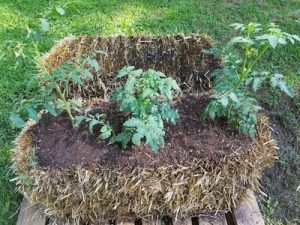Straw Bale Gardening
By Elizabeth Cornell Fake, Fairfax Master Gardener
Here is an interview with Leighton Jones, FCMGA Intern, who has been Straw Bale Gardening for the past six years.
What made you decide to start Straw Bale Gardening?
I live on a farm in Fairfax Station with six acres and ample acreage with good conditions for any type of gardening. I have sun and shade, good exposure and plenty of land. But, with all of the work associated with a farm, we just didn’t have time to garden. About six years ago, I wanted to get rid of some old hay. I advertised the bales for sale on Craig’s List and eventually sold them to a lady who just moved to Falls Church from Alaska. The lady wanted to start a Hay Bale Garden. Evidently, Hay Bale Gardening is popular in Alaska because of the Permafrost. I was intrigued with the idea.
 How do you describe Straw Bale Gardening?
How do you describe Straw Bale Gardening?
Straw Bale Gardening is a type of raised bed and container gardening. I thought it would be good for someone like me who is getting older and cannot till or cultivate beds or get down on the ground to plant and weed. It is knee-level gardening. The bales are scruffy looking and aren’t as attractive as a well-tended garden or bed, but the vegetable yields are well worth the effort. Also, the bales eliminate a lot of the plant diseases, pests and insects that plague regular gardens.
How do you get started?
You need to start with straw bales not hay bales. Straw is the leftover shaft of a grain crop, such as wheat, from which the seed heads have been harvested. The leftover shaft is cut and bailed. Straw is normally used for animal bedding in a barn or for garden mulch. On the other hand, hay is a grass crop used for animal feed. Either can be used for bale gardening, but straw allows for air circulation and retains water with less mold and mildew than hay.

tomatoes in straw bales
It takes about three weeks of preparation. First, you have to water the bale every day, so the straw begins to compost. Position the bales so the hollow tubes of the straw are on the top edge. This makes it much easier to water the entire bale, and the water is absorbed more quickly and efficiently. Then every other day, you add some kind of fertilizer to the site. I use regular lawn fertilizer, composted horse manure, blood and bone meal and basic 10-10-10 fertilizer. The nitrogen will start composting the interior of the bail; the warmer the outside temperature, the faster it composts. The residual heat from the compost creates a good environment for seedlings and root development. You can start planting your garden in the straw bales several weeks earlier than a regular garden.
How do you plant in a straw bale?
The first year I dug the holes by hand and swore I’d never do it again. It was very difficult to break through the wet straw. Now, I use a power drill with an auger to make the holes, and it is much easier to get started. Mostly, I plant seedlings right into the straw compost. I grow carrots from seed and lay down a layer of planting medium on top of the straw to get started.
 What do you grow in straw bales?
What do you grow in straw bales?
First, you have to remember this is an “annuals only” project. The bales eventually biodegrade and cannot be used a second time. So, you aren’t going to have much luck with something like asparagus that takes time to produce a crop. The first year I planted five bales and grew a 40-pound watermelon, more tomatoes than you could eat, potatoes, carrots and strawberries. The strawberries did not do as well as the other plants but that’s because it takes several years to establish a strawberry bed, which isn’t feasible with straw bales. Potatoes are interesting because you don’t really know when they are ready to harvest. At the end of the season, when I think they are ready, I cut the strings on the straw bale, and the potatoes pour out.
Presently, I have 12 bales going including two that are for flowers to attract pollinators to the vegetables.
Do you have any advice for someone considering getting started with Straw Bale Gardening?
You should do your homework and do some reading before you get started. I’d recommend Straw Bale Gardening by Joel Karsten. He’s also written several other books on the subject that are worth reading as well.
Resources
Straw Bale Gardening Complete, Joel Karsten, Brentwood, TN: Cool Spring Press, 2015
Straw Bale Gardening, Washington State University Fact Sheet, FS 109E